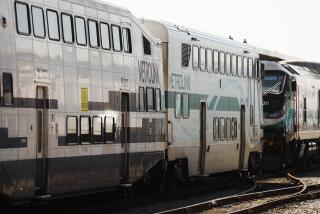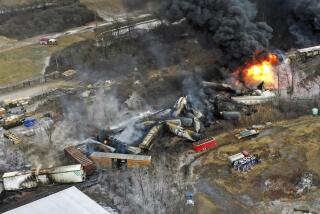Experts Split on Upgrades to Train Cars
Passengers in last weekâs Metrolink crash described how the impact threw them from their seats, slammed their heads and faces against walls and tables and tossed bodies around the cars.
âPeople were flying everywhere,â said passenger Susan Eisenbarth of Northridge.
The Wednesday morning crash, which involved three trains, killed 11 and injured at least 180, has sharpened debate among safety experts over whether trains can be built to better protect passengers from death or injuries in a collision.
Trains lack safety features that have long been standard on automobiles, such as seat belts, padded interiors and impact-absorbing crumple zones.
In addition, some say that the tables between train seats can become deadly during a crash.
But safety experts are split over whether such safety features should be required on trains. Meanwhile, the relative safety of trains makes it difficult to justify adding costly protective features, transportation experts said.
Although last weekâs collision was the deadliest on a U.S. railroad since 1999, the nationâs rail system seldom exceeds 10 passenger deaths a year, according to federal transportation statistics.
In the âcold, hard wayâ that decisions are made about building and regulating train safety, few will be willing to take steps âthat will cost tens of millions, even if it saved everybody,â said Tom Peacock, director of operations and technical services for the American Public Transportation Assn., which represents transit agencies, including Metrolink.
The value of seat belts for trains remains an open question. Rail workersâ unions have advocated for seat belts on trains, while some experts say they are unnecessary.
In most accidents, train passengers are less likely to be thrown about, as in an automobile, because heavy trains do not react as violently in collisions. But passengers can be thrown in severe impacts, as riders in the Metrolink crash experienced.
Peacock said seat belts could be costly because existing train seats might need to be replaced before belts could be fitted.
In some cases, âyou have seats that are three-across. If you had to [restrain] three 200-pound passengers you would need very strong anchors,â he said, which the undercarriages of some train cars might not be strong enough to support.
Ron Mayville, an expert on crashworthiness, said, âThe general consensus is seat belts would help. The question is whether they would actually be used.â
He said rail passengers would resist using them. âOne of the things I like about riding a train is not having a belt,â Mayville said.
âIt took more than 20 years to overcome public resistance to seat belts in cars,â Peacock said. âWeâd be starting all over.â
Passengers in last weekâs crash said they hit the tables between seats.
A federal study released in July on the 2002 Placentia Metrolink crash concluded the two passengers killed in that wreck probably died from injuries caused when their bodies were thrown into the tables in front of their seats.
Several other passengers in that crash who suffered serious injuries were seated at tables, the study found.
Eisenbarth, who was at a table in the last car of the Los Angeles-bound train in Wednesdayâs crash, said the woman seated next to her was thrown into the table.
âIt hit her right in the ribs. She was moaning, in serious pain,â Eisenbarth said.
Some are now questioning the safety of the tables.
âMaybe the regulations got it wrong,â Peacock said, adding that the tables are required to be strong, to hold passengers in place in a crash.
The tables could perhaps be made to give in at impact, he said. But each solution presents new challenges.
If the tables are removed entirely, the facing passengers âmight fly into each other, which could be worse,â Peacock said.
Along with protecting passengers inside the rail cars, the cars themselves could be modified.
In Europe, train cars are designed with crumple zones. In a crash, the front of the car is built to collapse in a controlled manner, absorbing the impact. The trunks and engine compartments of automobiles have long been designed to absorb collisions in this way.
âThe conclusion among knowledgeable people is thatâs a good thing,â said Peacock of crumple zones.
But the same kind of consumer demand and regulatory pressures that can alter the way car manufacturers build automobiles do not apply to train builders.
In the U.S., trains lack crumple zones but are built to a heavier, more rigid standard.
To get manufacturers to equip U.S. trains with crumple zones, âyou would need a big order from some railroad to buy a couple hundred cars and pay the additional cost.â
In the U.S., however, âorders typically come in the tens,â Peacock said.
Trains are built to safety standards set by the federal government and the public agencies that buy them.
Manufacturers do little research and development, leaving that work to researchers with the federal government.
Along with low volume, the public agencies that purchase trains seek the lowest bidder, which gives manufacturers no incentive to build beyond contract specifications.
And passenger rail systems -- all of which are heavily subsidized -- must keep ticket prices competitive with driving cars, so few costs can be passed on.
Some experts believe the Metrolink crash was more severe because the train that slammed into the Jeep Grand Cherokee was led by a lighter cab car, a modified passenger car, instead of a heavier locomotive.
Mayville said European trains led by cab cars now have longer noses to better handle crashes.
The drawback of this design is that such cars cannot be used in the middle of a train, limiting a rail lineâs flexibility to quickly add or remove cars.
Alan Bing, an engineer with ICF Consulting, a Lexington, Mass., firm that advises the federal government and railroad companies, said that in England, the lead car must meet minimum mass requirements, and passengers must be kept a certain distance from the front of the train.
Such measures âmight have helped in this case,â he said.
More to Read
Sign up for Essential California
The most important California stories and recommendations in your inbox every morning.
You may occasionally receive promotional content from the Los Angeles Times.










